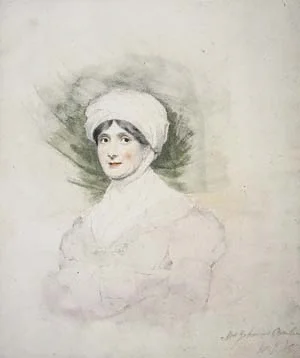BAILLIE, JOANNA (1762-1851)
BAILLIE, JOANNA (1762-1851), British poet and dramatist, was born at the manse of Bothwell,
on the banks of the Clyde, on the 11th of September 1762. She belonged to an old Scottish
family, which claimed among its ancestors Sir William Wallace. At an early period she moved
with her sister Agnes to London, where their brother, Dr Matthew Baillie, was settled. The
two sisters inherited a small competence from their uncle, Dr William Hunter, and took up
their residence at Hampstead, then on the outskirts of London, where they passed the
remainder of their lives. Joanna Baillie had received an excellent education, and began very
early to write poetry. She published anonymously in 1790 a volume called Fugitive Verses; but it was not till 1798 that she
produced the first volume of her plays on the passions
under the title of A Series of
Plays. Her design was to illustrate each of the deepest and strongest passions of the human
mind, such as hate, jealousy, fear, love, by a tragedy and a comedy, in each of which should
be exhibited the actions of an individual under the influence of these passions. The first
volume was published anonymously, but the authorship, though at first attributed to Sir
Walter Scott, was soon discovered. The book had considerable success and was followed by a
second volume in 1802, a third in 1812 and three volumes of Dramas in 1836. Miscellaneous Plays appeared
in 1804, and the Family Legend in 1810. Miss Baillie
herself intended her plays not for the closet but for the stage. The Family Legend, brought out in 1810 at Edinburgh, under the
enthusiastic patronage of Sir Walter Scott, had a brief though brilliant success; De Monfort had a short run in London, mainly through the
acting of John Kemble and Mrs Siddons; Henriquez and
The Separation were coldly received. With very few
exceptions, Joanna Baillieʼs plays are unsuited for stage exhibition. Not only is there a
flaw in the fundamental idea, viz. that of an individual who is the embodiment of a single
passion, but the want of incident and the direction of the attention to a single point,
present insuperable obstacles to their success as acting pieces. At the same time they show
remarkable powers of analysis and acute observation and are written in a pure and vigorous
style. Joanna Baillieʼs reputation does not rest entirely on her dramas; she was the author
of some poems and songs of great beauty. The best of them are the Lines to Agnes Baillie on her Birthday, The Kitten, To a
Child and some of her adaptations of Scottish songs, such as Wooʼd and Married anʼaʼ. Scattered throughout the dramas
are also some lively and beautiful songs, The Chough and the Crow in Orra, and the loverʼs song in the Phantom. Miss Baillie died on the 23rd of February 1851,
at the advanced age of 89, her faculties remaining unimpaired to the last. Her gentleness
and sweetness of disposition made her a universal favourite, and her little cottage at
Hampstead was the centre of a brilliant literary society.
See Joanna Baillieʼs Dramatic and Poetical Works (London, 1851).
[contributor not given]
